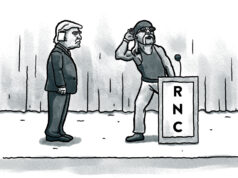Even before the shocking defeat of Hillary Clinton, veteran commentators were describing the 2016 presidential election as the demise of The Third Way, the neoliberal or “New Democrat” policies that President Bill Clinton personified.
As Thomas Frank explained in his book, Listen Liberal!, Republicans represent the One Percent, but Democrats have also abandoned “the People,” becoming the party of the “Ten Percent,” aka the elite professionals who staffed the Clinton and Obama administrations. Frank’s book further explains how these Democrats have become devoted to elite professionals, and how they have created a “second hierarchy” based on “credentialed expertise.”
Although probably not one of the main reasons for the 2016 Democratic defeat, education reform could have cost Clinton electoral votes in Michigan and Pennsylvania. Because it is the policy that I most fully understand, I will describe education reform as a metaphor for how “the Billionaires Boys Club” and the Obama administration pushed technocratic policies that helped open the door for Trump’s victory.
Obama’s policies failed to trickle down
First, then-Secretary of Education Arne Duncan staffed his agency with Gates Foundation wonks and imposed a set of Gov. Scott Walker-lite, anti-union, anti-teacher corporate school reforms. Second, the Democratic Party remained on the sidelines during the campaigns to resist Right to Work and recall Walker and Koch-funded legislators. As they should be, deep-pocket donors and the Ten Percent, are always quick to open their wallets in support of liberal social issues, however, they seemed oblivious to the need to support blue collar workers and teachers.
During his second term, President Obama reclaimed his voice and advocated for working people (excluding teachers’ unions), but by then he had little leverage for enacting progressive legislation. So, while I was heartened by Obama’s words, they rang hollow to the casualties of the global marketplace. White workers in Wisconsin, Michigan, Ohio and Pennsylvania often lashed out, wrongly, at immigrants and people of color when their real beef should have been with corporate powers as well as politicos who ignored their hardships.
Pushing teachers to the edge of the working class
Again, education policy was only one part of The Third Way agenda. I’m not saying that when the new President Obama made a snap judgment and endorsed the mass firings of teachers in Central Falls, Rhode Island — without regard for their job performance — that the entire labor community instantly noticed. But, liberal talking heads then jumped at the chance to sound tough by endorsing the mass dismissals of veteran teachers merely because corporate reformers told them that 20-somethings would be better teachers.
When progressives picked up the mantra that urban teachers should be worked so hard that they would be used up before they turned 30, it demonstrated their disrespect for all workers, not just the “semi-profession” of education. This callousness illustrated their broader disregard for people who lived “the working, the working, just the working life,” as Bruce Springsteen puts it in the video above.
Charter expansion spills out from Ohio
The extreme expansion of Ohio charter schools that were “incentivized” by the Obama administration was just a small part of that state’s defeat. Its support of mass charterization could have made much more of a difference in the close Michigan and Pennsylvania races. Third Way Democrats cheered the mass closure of schools in Detroit, Philadelphia and other urban districts, as large numbers of veteran teachers, union members with generous salaries, were often replaced by young Teach for America graduates from elite universities with backgrounds similar to the Ten Percent.
Perhaps more important in terms of electoral politics, neoliberal reformers were oblivious to the fate of thousands of support workers who lost their benefits and wages when charters took over their traditional public schools.
The loss of good-paying jobs and unions further weakened the ability of the Democratic Party to reach out to working families. As Frank notes in his book, that is only part of the problem that helped open the door for Trump. First, it showed how detached the Ten Percent were from the working world. They bought the claim, “If we just launch more charter schools, give everyone a fair shot at the SAT, and crank out the student loans,” education “will dissolve our doubts about globalization.”
Successes of Ten Percent an affront to workers
Frank writes, “To the liberal class, every big economic problem is really an education problem.” Obama’s education policy increased segregation, undermined the teaching profession, broke the morale of many educators and benefitted right-wing union haters. At the same time, his policies drove student performance down, but the administration couldn’t face up to these facts because, “To the liberal class this is a fixed idea, as open to evidence-based refutation as creationism is to fundamentalists,” as Frank writes.
Perhaps because I remained such an Obama loyalist overall, a set of Frank’s observations completely escaped me. Whether we are talking education, social policy or international philanthropy, the Ten Percent are all over the media. The grandiose celebrations of their charitable contributions are offensive to many blue collar workers. Many see their self-congratulatory promotion of the issues close to their hearts as obnoxious reminders of who they don’t care about. This not only sticks in the craw of struggling workers, but it contributes to the wrong-headed assertions of white workers that they have been abandoned while the government and the rich supposedly protect immigrants and people of color.
‘A moral judgment from the vantage of success’
In no way do I want to diminish the horrific return to xenophobia. Neither do I claim that education reform is more than one factor that has damaged Democrats. But, to understand Donald Trump’s victories in the Midwest, we must take into account Frank’s explanation that the Ten Percent’s prescription for better teaching as the cure for poverty is “less a strategy for mitigating inequality than it is a way of rationalizing it.”
Moreover, the seemingly weird idea that education reform can defeat poverty is “a moral judgment handed down by the successful from the vantage of their own success.” When the Ten Percent celebrate their accomplishments and their supposed contributions to education, they need to remember that downwardly mobile workers are watching, and they don’t appreciate the extravaganza.
The results of the recently concluded election will make our economy worse, but we can’t fend off an arrogant and dangerous star of reality TV without getting back to the hard, human facts of economic reality.





















